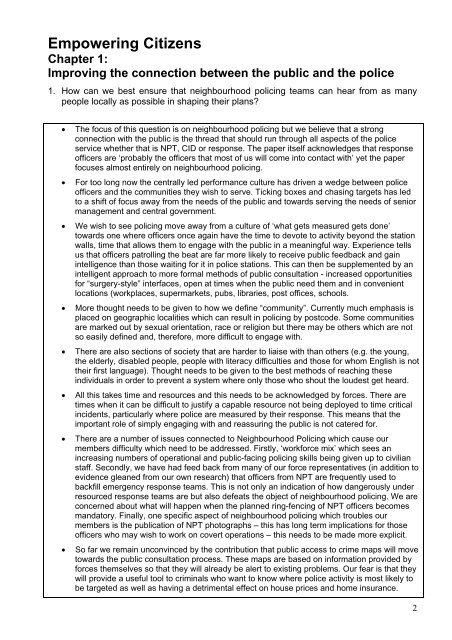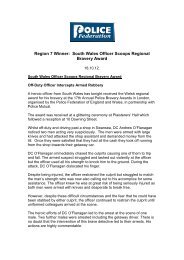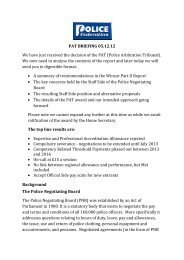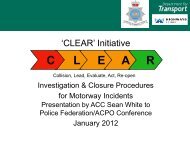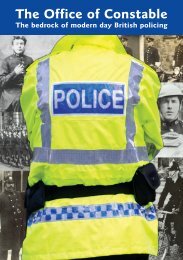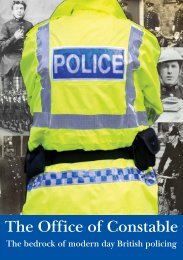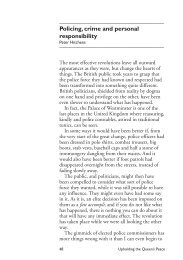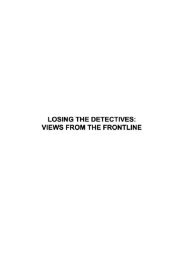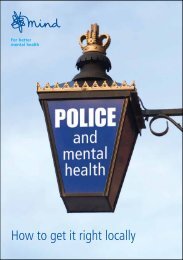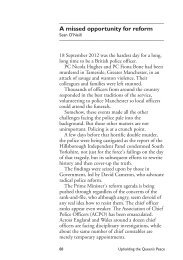THE POLICING GREEN PAPER - Police Federation
THE POLICING GREEN PAPER - Police Federation
THE POLICING GREEN PAPER - Police Federation
Create successful ePaper yourself
Turn your PDF publications into a flip-book with our unique Google optimized e-Paper software.
Empowering Citizens<br />
Chapter 1:<br />
Improving the connection between the public and the police<br />
1. How can we best ensure that neighbourhood policing teams can hear from as many<br />
people locally as possible in shaping their plans?<br />
• The focus of this question is on neighbourhood policing but we believe that a strong<br />
connection with the public is the thread that should run through all aspects of the police<br />
service whether that is NPT, CID or response. The paper itself acknowledges that response<br />
officers are ‘probably the officers that most of us will come into contact with’ yet the paper<br />
focuses almost entirely on neighbourhood policing.<br />
• For too long now the centrally led performance culture has driven a wedge between police<br />
officers and the communities they wish to serve. Ticking boxes and chasing targets has led<br />
to a shift of focus away from the needs of the public and towards serving the needs of senior<br />
management and central government.<br />
• We wish to see policing move away from a culture of ‘what gets measured gets done’<br />
towards one where officers once again have the time to devote to activity beyond the station<br />
walls, time that allows them to engage with the public in a meaningful way. Experience tells<br />
us that officers patrolling the beat are far more likely to receive public feedback and gain<br />
intelligence than those waiting for it in police stations. This can then be supplemented by an<br />
intelligent approach to more formal methods of public consultation - increased opportunities<br />
for “surgery-style” interfaces, open at times when the public need them and in convenient<br />
locations (workplaces, supermarkets, pubs, libraries, post offices, schools.<br />
• More thought needs to be given to how we define “community”. Currently much emphasis is<br />
placed on geographic localities which can result in policing by postcode. Some communities<br />
are marked out by sexual orientation, race or religion but there may be others which are not<br />
so easily defined and, therefore, more difficult to engage with.<br />
• There are also sections of society that are harder to liaise with than others (e.g. the young,<br />
the elderly, disabled people, people with literacy difficulties and those for whom English is not<br />
their first language). Thought needs to be given to the best methods of reaching these<br />
individuals in order to prevent a system where only those who shout the loudest get heard.<br />
• All this takes time and resources and this needs to be acknowledged by forces. There are<br />
times when it can be difficult to justify a capable resource not being deployed to time critical<br />
incidents, particularly where police are measured by their response. This means that the<br />
important role of simply engaging with and reassuring the public is not catered for.<br />
• There are a number of issues connected to Neighbourhood Policing which cause our<br />
members difficulty which need to be addressed. Firstly, ‘workforce mix’ which sees an<br />
increasing numbers of operational and public-facing policing skills being given up to civilian<br />
staff. Secondly, we have had feed back from many of our force representatives (in addition to<br />
evidence gleaned from our own research) that officers from NPT are frequently used to<br />
backfill emergency response teams. This is not only an indication of how dangerously under<br />
resourced response teams are but also defeats the object of neighbourhood policing. We are<br />
concerned about what will happen when the planned ring-fencing of NPT officers becomes<br />
mandatory. Finally, one specific aspect of neighbourhood policing which troubles our<br />
members is the publication of NPT photographs – this has long term implications for those<br />
officers who may wish to work on covert operations – this needs to be made more explicit.<br />
• So far we remain unconvinced by the contribution that public access to crime maps will move<br />
towards the public consultation process. These maps are based on information provided by<br />
forces themselves so that they will already be alert to existing problems. Our fear is that they<br />
will provide a useful tool to criminals who want to know where police activity is most likely to<br />
be targeted as well as having a detrimental effect on house prices and home insurance.<br />
2


